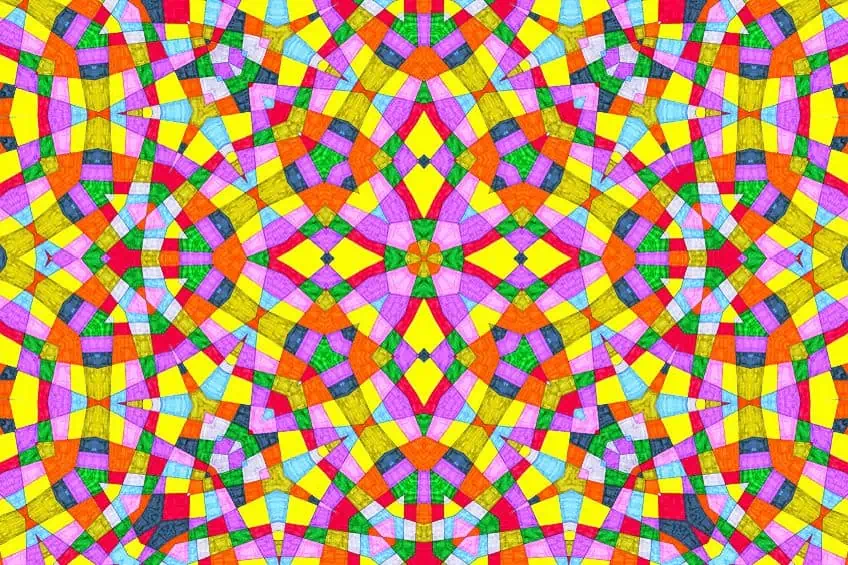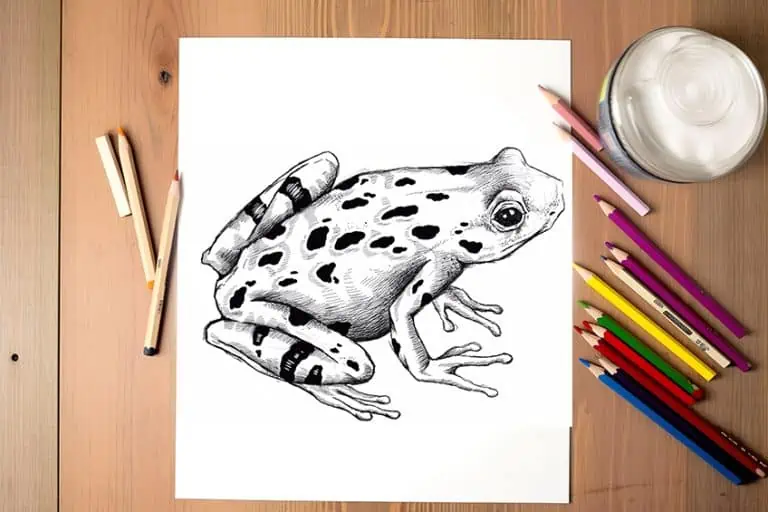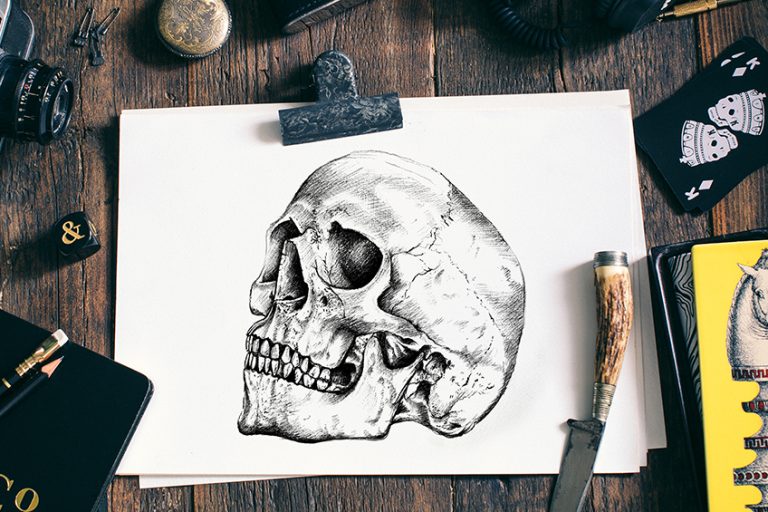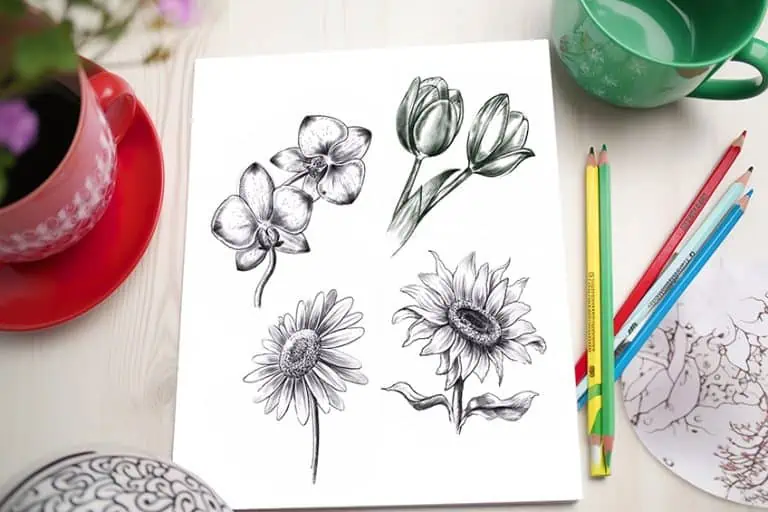What Is a Mandala? – Learn About Mandala Symbolism
This post may contain affiliate links. We may earn a small commission from purchases made through them, at no additional cost to you.
What is a mandala and what are mandalas used for? Mandala art consists of geometric designs believed to have great symbolic significance for Buddhist and Hindu cultures. Mandala symbolism includes portraying various aspects of the universe, including physical and spiritual realms. This article will explore the history of mandalas, the different types of mandalas, and their meanings, as well as answer relevant questions, such as, “what is the purpose of a Mandala?”.
Table of Contents
What Is a Mandala and What Is It Used For?
Mandalas are basically circles enclosed within a square and grouped into sections that are all arranged around a singular, central axis. Mandala artworks are usually created on fabric or paper, drawn with threads on a surface, formed from bronze, or constructed in stone. While still appealing as works of art, a mandala’s meaning and symbolism are what give the piece value. In Asian traditions, a mandala is regarded as a spiritual and ceremonial symbol.

Mandala art can be interpreted in two ways: outwardly as a visual depiction of the cosmos or internally as instructions for a number of practices common throughout numerous Asian traditions, such as meditation. According to Buddhism and Hinduism beliefs, entering the mandala artwork and moving towards its center guides you through the universal process of changing the cosmos from one of pain to one of pleasure and happiness.
The History of Mandalas
The person who founded Buddhism, Siddhartha Gautama, was born in what is nowadays referred to as Nepal. Though no exact date is known, historians estimate he was born sometime around 560 BCE. Gautama is reputed to have left his kingdom after he grew conscious of human suffering in order to seek enlightenment by means of regular meditation and conscientious behavior. He proceeded to impart his views throughout India, garnering devoted adherents and eventually establishing the first Buddhist community of monks, or sangha.
These Buddhist monks spread Buddhism around the world as they traveled the Silk Road, a significant network of trade routes connecting the West and the East.
They took mandala art with them and spread the tradition of painting these mystical designs across Asia, eventually surfacing in places such as China, Tibet, and Japan by the 4th century CE. Though they originated from Buddhism, mandalas quickly spread to Hinduism and other religions. These spiritual artists were often religious laymen who had been commissioned by a patron. They sat on the floor, with a painting positioned in front of their crossed legs or on their lap, and painted the mandala artworks meticulously in this position.
The Cultural Significance of Mandala Art
Mandala art can be found in many cultures and their significance often varies from one place to another. Mandala art is found in Buddhism, Hinduism, Mesoamerican cultures, and even in modern psychology!
Let us now delve a bit deeper into the cultural significance of mandalas in these various religions and contexts.
Mandala Art in Hinduism
In Hinduism, the most popular types of mandalas produced are called yantras. Yantras are mystical geometric designs used in Hinduism as symbolic representations of various gods or cosmic forces. Yantras are elaborate mandalas that have been used for devotional purposes, meditation, and drawing in spiritual forces. Each yantra features geometric patterns and mandala symbolism that are associated with one particular deity or cosmic force. Mandalas are also important in Hindu rituals and devotional activities.

They serve as holy diagrams in addition to depictions of deities. Priests would make temporary mandalas during ceremonies known as pujas using colorful powders, flower petals, or grains of rice. These mandalas also contributed to the establishment of a sacred space for the ceremonies to take place. In Hinduism, mandalas are also connected to one’s spiritual journey and the desire for enlightenment. The elaborate patterns depict the complex structure of life, consciousness, and the cosmos.
Mandala Art in Buddhism
The mandala is used to visually express the essence of Vajrayana teachings in Buddhism. To these Buddhists, the mandala reflects the beauty of the enlightened mind. These Buddhist mandalas may further symbolize the entire cosmos, which is usually represented by Mount Meru in the middle and the continents around it. The outer circle of flame in a Buddhist mandala generally represents knowledge.
The circle of eight charnel grounds depicts the Buddhist precept to constantly be mindful of one’s mortality and the impermanence that permeates samsara.
Within these circles are the walls of the mandala palace, which is occupied by various Indian gods and Buddhas. For the Buddhists, mandala art serves as a tool for meditation, a thing intended to be contemplated repeatedly until the visual representation of the mandala eventually becomes completely internalized and can then be called upon and envisioned at will as a vivid and clearly imagined image.
Mandala Art in Jainism
Vardhamana, a sage, helped to establish Jainism. Adherents refer to him as the 24th Tirthankara, and they believe he belongs to a long line of enlightened beings who comprehended the illusory nature of life and liberated themselves by means of continuous spiritual practice that interrupted the cycle of samsara and led to freedom. Jains follow the same discipline with the intention of accomplishing the same objective.
 The “Charan Paduka” or foot impression of Mahavira at Jal Mandir; Solariseknight, CC BY-SA 4.0, via Wikimedia Commons
The “Charan Paduka” or foot impression of Mahavira at Jal Mandir; Solariseknight, CC BY-SA 4.0, via Wikimedia Commons
Images of Mahavira in the middle of a circle surrounded by ever-widening squares depicting various holy spirits or life conditions are found in Jain mandalas to illustrate this discipline. A Jain mandala’s details can vary from one version to another, but Mahavira typically appears in the middle, and the person viewing it is urged to navigate the image from the outside ring of distractions and illusions into the center truth presented by Mahavira. In a calm state of contemplation, the viewer is presented with a spiritual map of the Jainism path.
Mandala Art in Mesoamerican and Native American Cultures
Calendars of the Maya civilization were often presented in the form of a mandala. It is comparable in shape and purpose to Tibetan Buddhists’ Kalachakra sand artwork. The Aztecs of Central and South America utilized the mandala design to create magnificent calendars and to record holy concepts. The Aztec Sun Stone is believed to be a ceremonial depiction of the entire cosmos as perceived by the Aztec religious class, resembling an Eastern mandala in many aspects.
Many native tribes throughout the Northern American continent also utilized mandalas for communication with the gods.
These often consisted of circular shapes constructed from the skins of hunting animals, with feathers and other found materials incorporated. While many Native cultures employ mandalas as forms of art, the circular pattern is also important in ceremonial rituals. It may be observed in several native dances, both as individual motions and as a larger movement centered on a central point, usually a fire or a person of significance.
Psychological Interpretations of Mandala Art
Carl Gustav Jung is primarily credited with reintroducing mandalas into modern Western psychology. Jung recognized the ubiquitous presence of a circular pattern throughout faiths and cultures during his research of the unconscious through art. He theorized that the circular paintings mirrored the inner state of the mind at the time of creation and served as a form of meaningful archetype in the collective unconscious of mankind.

Jung’s familiarity with Indian texts on philosophy led him to coin the term “mandala” to characterize the drawings he and his patients drew. Jung said that the desire to create mandalas arises during periods of intensive personal growth. The mandala symbolism, according to David Fontana, a transpersonal psychologist, could potentially assist people in accessing incrementally more profound dimensions of the unconscious, eventually allowing the meditator to feel a mystifying sensation of oneness with the supreme unity from which the universe in all its multiple forms arises.
Mandala Symbolism
Many symbols can be found in mandalas’ complex circular designs. Traditionally, they feature an aspect of Buddha’s mind in an abstract form, most typically portrayed as a tree, wheel, flower, or jewel. The middle is a dot, which is a dimensionless symbol. It is viewed as the focal point of contemplation and reverence for the divine. From that point, the dot is enclosed by lines and geometric designs that depict the cosmos, and it is enclosed by an outer circle that symbolizes the cyclical aspect of life.
The wheel with eight spokes is regarded as an important symbol in Buddhism and can also be found in Hindu mandalas.
It depicts the Noble Eightfold Path, which leads to release from suffering and attaining enlightenment. Each spoke of the wheel reflects one of the path’s eight aspects. The wheel represents the never-ending circle of life as well as Buddha’s teachings. Another significant symbol in the Buddhist and Hindu faiths is the bell. The bell denotes wisdom, understanding, and the feminine component of divinity. It is used in ceremonies to purify the surroundings and represents the sound of enlightenment.

The triangle is quite a common symbol in mandalas with several interpretations. It symbolizes the three basic qualities of existence: creation, preservation, and decay. These are related to the Hindu deities Vishnu, Brahma, and Shiva. The triangle also symbolizes the balance and equilibrium of the mind, body, and soul. It represents the holy triad, the divine feminine, and the ascension from lower planes of awareness to higher spiritual realms. The lotus flower is significant in many cultures and faiths, including Hinduism. It is a popular mandala motif that denotes the beauty of spiritual awakening. The lotus emerges from dirty waters yet remains unharmed, blossoming above the surface, representing the path from ignorance to wisdom.
The lotus flower symbolizes divine consciousness as it arises from the material world. The lotus’s several layers of petals represent various stages of spiritual enlightenment. In Hinduism, the sun is a potent symbol, signifying the source of energy, light, and life. The sun shines its energy outward in mandalas. It represents spiritual illumination and an everlasting wellspring of divine comprehension.
In Hindu mythology, the sun is connected with deities such as Savitur, Surya, and Aditya and is seen as a symbol of cosmic harmony and the presence of the divine.
The Different Types of Mandalas
Mandalas differ in function and style from one location to another, and from one belief system to another. Some mandalas are used for teaching, while others are used for healing. Every line, form, and color in a teaching mandala illustrates a distinct element of a specific religious or philosophical system. The makers of teaching mandalas use them as vivid mental maps. Healing mandalas tend to be more intuitive than mandalas used for instruction and are designed for meditation.
Healing mandalas are designed to impart knowledge, instill tranquility, and channel concentration and focus.
Sand Mandalas
Sand mandalas are complex and beautiful designs made from colored sand grains. They are a distinct kind of mandala artwork with substantial significance in Tibetan Buddhism. The impermanence of sand mandalas is one of its most striking characteristics. The completed mandala is purposely destroyed after hours, days, or even weeks of meticulous production. This act represents the temporariness of all things and serves to remind us of our own impermanence. The technique embodies the Buddhist philosophy of non-attachment and embracing life’s fragility.
 Image of sand mandala; The original uploader was Colonel Warden at English Wikipedia., CC BY-SA 3.0, via Wikimedia Commons
Image of sand mandala; The original uploader was Colonel Warden at English Wikipedia., CC BY-SA 3.0, via Wikimedia Commons
The technique of creating a sand mandala is very precise and ceremonial in nature. Before starting, the monks cleanse the location and chant prayers to bring in blessings and good energy. They then use complex tools such as metal rods and funnels to meticulously distribute the colorful grains of sand onto a flat surface. The monks operate in a deeply meditative state of mind, paying close attention to every little detail. The ceremony includes the eventual dissolution of the sand mandala after creation. This entails delicately brushing sand grains together in a precise pattern, signifying the return of all things to their original state.
Thangka Mandalas
Thangka mandalas are traditional Buddhist paintings produced on silk or cloth that are usually used for teaching, meditation, and religious devotion. Thangka mandalas are highly regarded and considered sacred in Tibetan Buddhism. They are designed by professional artists who typically adhere to strict iconographic and artistic rules. Thangkas are used as tools for deep inner contemplation, and connecting with the spiritual realm. They signify the cosmos, the interconnection of all things, and the road to enlightenment.
Within the mandala, a main deity or principle is usually portrayed, surrounded by different concentric circles and elaborate patterns.
People engage with these mandalas by focusing on the principal god or principle, utilizing it as a point to focus all their attention in order to enter a state of deep meditation and acquire certain traits associated with the deity depicted. The magnificent patterns and symbolism of the Thangka Mandala aid with inner visualization, allowing people to connect with the divine and gain a deeper understanding of Buddhist beliefs. Thangka mandalas are typically used in many Buddhist festivals and ceremonies. During religious festivals, they are often shown in temples, monasteries, and private homes.
Yantra Mandalas
Yantra Mandalas are very precise and complex geometric designs created using sacred geometry. These designs are usually symmetrical and comprise squares, circles, triangles, and other geometric forms. The combination of the aforementioned shapes depicts the universe’s fundamental structure and acts as a visual tool for focusing one’s thoughts during a meditation session.
 Mandala of Vishnu; Jayateja (, died N/A), Public domain, via Wikimedia Commons
Mandala of Vishnu; Jayateja (, died N/A), Public domain, via Wikimedia Commons
These Yantra mandalas are usually accompanied by particular sacred sounds called mantras that are connected with the respective deity or principle portrayed. A vital synergy is created by combining the visual depiction (Yantra) and the aural recitation of the mantra. While staring at the Yantra, reciting the sacred words increases the meditative experience and deepens one’s connection with the divine.
What Are Mandalas Used For?
Due to their creative and spiritual nature, mandalas can be used in a range of different situations. As we have learned, people have traditionally used it for meditation and religious ceremonies. However, there are some people who like to use it as home decor due to its vibrant colors and interesting geometrical designs. Some love mandalas so much that they even end up getting them as tattoo designs!
Let us find out more about the different uses of mandalas in everyday life.
Meditation
Mandalas are often used as meditation tools because they are known to focus one’s mind and help induce a feeling of deep relaxation. Begin by choosing a mandala that speaks to you. Traditional designs can be found, or you can design your own or even use one of the many mandala coloring books that are available online. A central focus point and symmetrical designs should be present in the mandala.
Choose a quiet peaceful place to meditate away from distractions. This can be a specific meditation area, a quiet corner of a room, or any place where you can feel calm and can concentrate.
Place the mandala in an ideal location in your space where it can be properly viewed in its entirety, but not too far that you cannot observe all of the fine details. Allow yourself to enter a state of relaxation by taking a few deep breaths. Then, close your eyes and shift your focus within. Recognize and intentionally release any anxiety or stream of thoughts in your head.
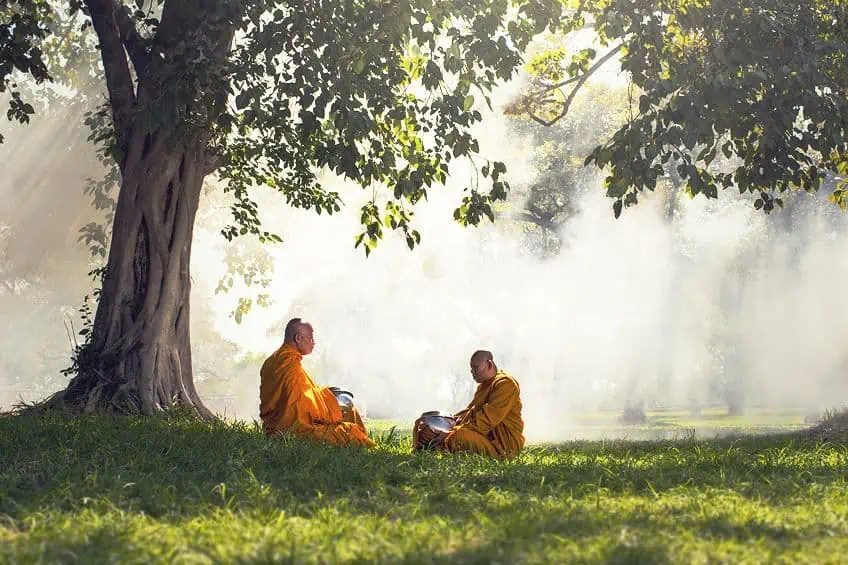
Create an inner sensation of serenity and tranquility. Open your eyes and slowly direct your sight to the mandala’s central point. Let your eyes explore the mandala’s complex features and designs, allowing the visual images of the mandala to flow into your mind. Allow the mandala to elicit emotions, feelings, or insights inside of yourself.
You could, for example, contemplate the mandala’s meaning or your own inner journey of self-discovery.
Art Therapy
Mandalas are popular in art therapy because of their relaxing and centering properties, in addition to their capacity for self-discovery and expression. Patients are often provided with a blank circular template or encouraged to create a circle as a starting point for their mandala. Patients are then invited to experiment with various shapes, colors, and patterns that speak to them personally. Every element that they pick for the mandala has a particular meaning and symbolism.
Patients are then guided by the art therapist in understanding their choices and analyzing possible interpretations and meanings associated with their mandalas.
Patients are given instructions to concentrate on staying in the present moment and engaging in conscious art-making. Coloring in the mandala’s patterns is repetitive, which can help relieve stress, create a state of relaxation, and improve one’s attention. Mandala art therapy allows for nonverbal self-expression. Patients can utilize symbols and colors to discover and convey their feelings, thoughts, and inner experiences. Making mandalas promotes introspection, and self-reflection, and can help one find hidden aspects of one’s unconscious mind.
Home Decor
Mandalas’ elaborate and symmetrical forms are both beautiful and artistically pleasant, making them ideal for use in interior design. Mandalas are often utilized as wall decorations in homes. They are available as paintings, posters, tapestries, and wall decals. Large mandala artworks may be used as a room’s focal point, providing a sense of elegant spirituality. Mandala designs can also be found on cushions and pillows, adding color to chairs, sofas, and beds.
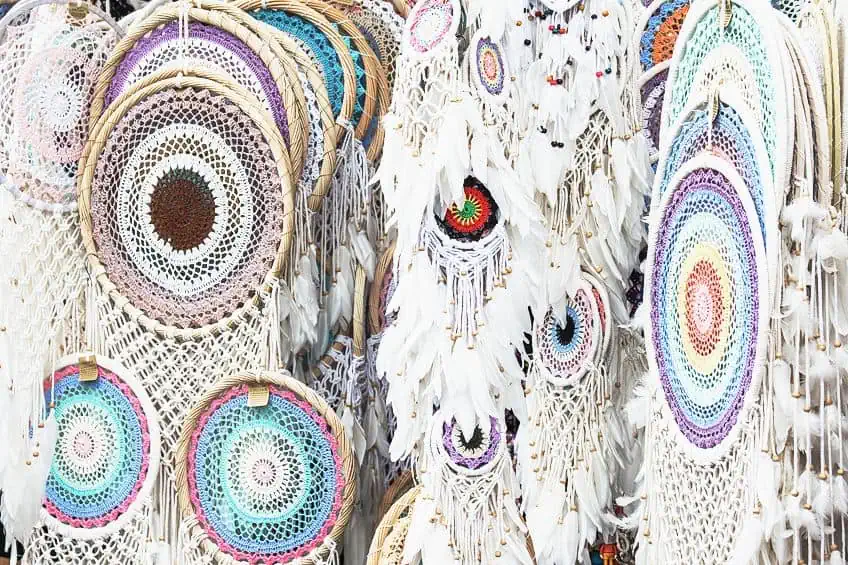
These add a bohemian touch to your living space. Mandalas are occasionally also used in carpet and rug designs. They can be employed to anchor a sitting area or provide a visually appealing feature to the floor. They can also be incorporated into linen, bedding, curtains, and furniture accents. When adding mandalas to their home décor, people typically select designs and colors that fit the overall style and mood of their space.
Mandalas and Chakras
Chakras are yet another type of mandala, and we can thank Hinduism for that. The name “chakra” means “wheel” in Sanskrit, implying that they, similar to mandalas, depict the cyclical aspect of existence. Chakras, though, are more than simply visually beautiful symbols: they relate to particular nerve networks and centers, as well as physical organs.
These seven energy centers (represented by the imagery of spinning wheels) are the physical expressions of our chakras, forming a perfectly parallel vertical line up through our bodies, representing a kind of spiritual spinal cord.
The Chakras
Muladhara is the name given to the Root Chakra located at the base of your spine and is concerned with anchoring and grounding. This symbol’s square denotes rigidity, solidity, and underlying energy. It serves as a strong foundation for the chakra system. The upside-down triangle is the alchemical sign for Earth, and it also represents Muladhara’s grounded energy. This symbol’s four petals reflect the four mind-states that arise from this chakra: intellect, mind, awareness, and ego. Svadhishthana is the name given to your Sacral Chakra, or creative center.

The rings connected to the petals of the lotus flower signify the cyclical process of birth, death, and rebirth. The Manipura Chakra is known as your Solar Plexus Chakra, and it has a direct impact on your confidence. The 10 petals of this symbol correspond to the ten Pranas in your body, or, to put it another way, different sorts of air energy manipulation. Anahata refers to your Heart Chakra, which feeds your compassion for yourself and others. Vishuddha is otherwise known as your Throat Chakra, which governs your capacity to communicate and advocate for what you believe in. Your Third Eye Chakra, or the seat of your intuition, is called Ajna. Your Crown Chakra, or spiritual link, is called Sahaswara.
Using Mandalas to Heal Your Chakras
Mandalas may be an effective tool for chakra healing because they focus and rebalance the centers of energy in the human body. Choose a mandala design that corresponds to the chakra you wish to concentrate on. You may discover chakra-specific mandalas on the internet or make your own by adding the chakra’s related hue and symbols. Direct your focus on the chakra that you would like to heal.
Focus on its color and position in your body. Imagine the chakra rotating and emitting energy.
Imagine the mandala’s energy pouring into the associated chakra, purifying and balancing it as you stare at it. Visualize the chakra swirling in unison and releasing an intense color. Continue to meditate for as long as you are feeling comfortable. If your thoughts begin to wander, just bring them back to the chakra and the corresponding chakra. Let the mandala’s healing energy and your intentions adjust and balance the chakra.
Making Your Own Mandalas
Consider your own mandala to be a reflection of your spirit. Drawing and coloring a mandala can turn into a truly enlightening personal experience in which you search inside yourself to discover the forms, colors, and designs to reflect anything from your present state of mind to your most deeply-felt intention for yourself, someone you love, or mankind. You can create a mandala to represent a mental state you want to reach. Mandalas are excellent tools to use for meditation and self-awareness.

The nicest part of creating your own mandalas is that you may use any designs or colors you like to represent your perception of self and your perspective on reality. Your mandala is your own, and you are free to use your imagination to design a mandala drawing that is entirely unique and meaningful to you. Once you’ve mastered the fundamentals of drawing a mandala, you can have fun experimenting with various designs and colors with each new mandala.
How to Create a Mandala
Begin by sketching circles, beginning with the largest circular form and moving inwards. Make four lines that connect across the center of the circle in the shape of a clock. If you want to create a more complex pattern, add more lines; there are no hard and fast rules when it comes to making your own mandalas. Make lines or shapes in one part, subsequently repeating the same shape throughout each section to create a symmetrical pattern.
You can make petal shapes as you would see in flowers or geometric shapes such as triangles.

Allow your mind to wander, and the layout will eventually come to you. When you’re finished with your drawing, you could also then add vibrant colors using paint, crayons, or colored pencils if you choose. The important thing to remember is that meditation is also in the creation of the mandala, not just focusing on it afterward. So, take your time and enjoy the process of creating your mandala, there is no rush.
Today, we looked at various types of mandalas and their meanings. Mandala is a Sanskrit word that means “circle”. Mandalas are geometric drawings that depict the cosmos, or more precisely, a microcosm of the cosmos. This arrangement of circles is intended to demonstrate how we are linked to the endless cosmos. That is why they tend to be so detailed and complex. The center represents our soul, or in certain Eastern religions, a specific deity or spiritual principle. Each circle indicates earthly layers that go beyond our intellect and physical bodies. Each layer eventually spreads beyond the planet to encompass the universe. This entire process demonstrates how interconnected we are as souls to the whole cosmos. The mandala is also a spiritual journey that leads us inward, beginning with the outside circles and working our way within.
Frequently Asked Questions
What Is a Mandala?
Mandalas are basically geometric artworks that serve both aesthetic and functional purposes. Deriving from Eastern religious practices, these elaborate and complex artworks serve as representations of the natural and spiritual realms. They would typically feature certain deities or religious concepts. Many modern mandalas favor the incorporation of geometric and natural shapes in the center instead of deities. As long as the design speaks to you on a deep and personal level, it can be used for meditation, self-reflection, therapy, healing, and understanding the interwoven nature of humanity and the surrounding cosmos.
What Is the Purpose of a Mandala?
The use of mandalas can be traced back many centuries to the emergence of Buddhism and Hinduism. For these people, mandalas were used specifically for religious reasons and meditation. Even today, they are used to help people focus on their inner selves, as well as in certain psychological settings for self-expression and understanding one’s unconscious mind.
Matthew Matthysen is a multidisciplinary artist. He completed his fine art degree, majoring in History of Art and Contemporary Drawing Practice at the University of Witwatersrand, South Africa. Before joining acrylgiessen In 2020, Matthew worked part-time as an art teacher at Reddford Blue Hills High school. Matthew creates drawing and painting tutorials for acrylgiessen and captures them not only photographically and in written form. He also records the creation of his works in his own creative studio as in video format, from which later with a voiceover and a video editor also drawing tutorials for the Youtube channel of acrylgiessen are created.
Learn more about Matthew Matthysen and about acrylgiessen.
